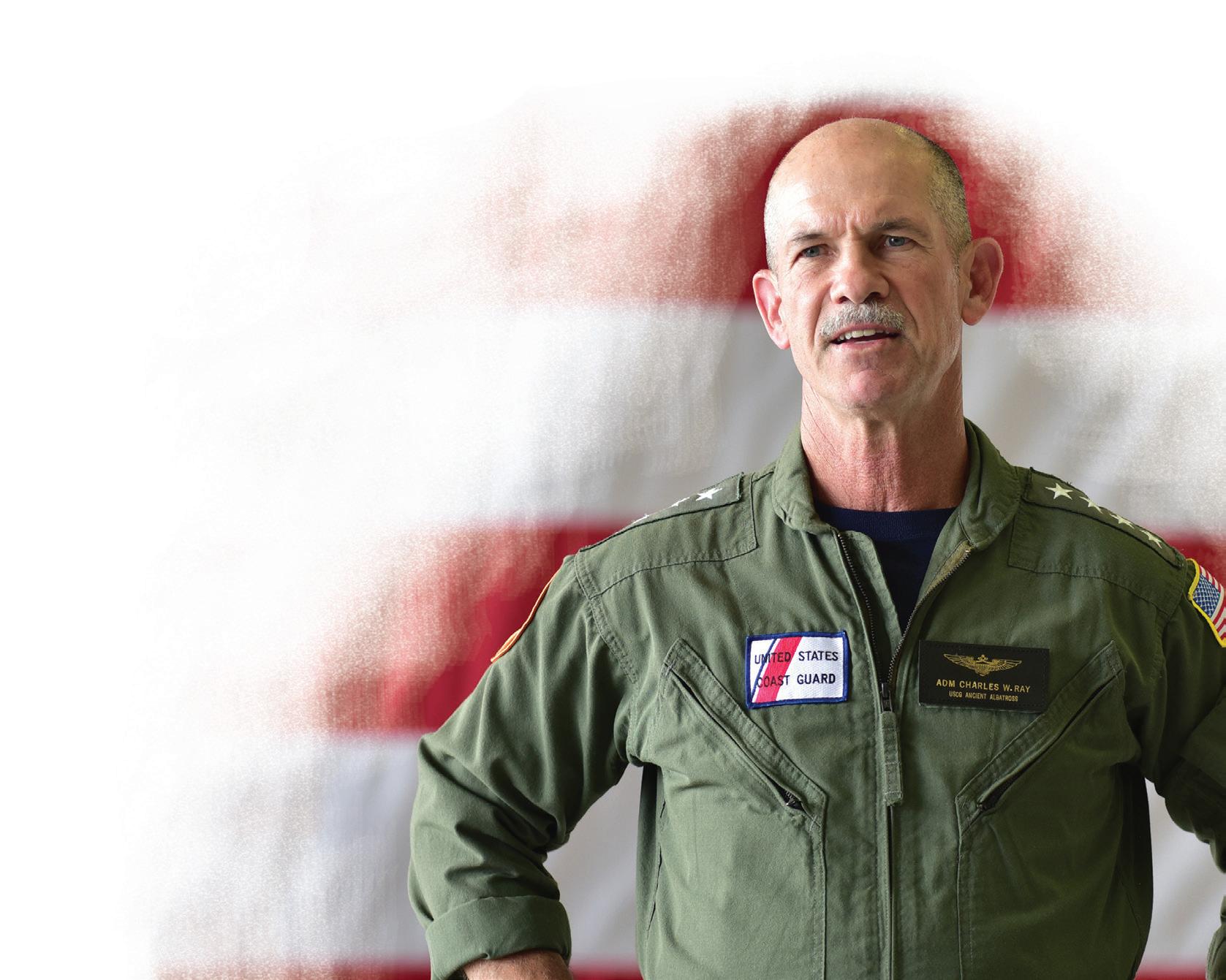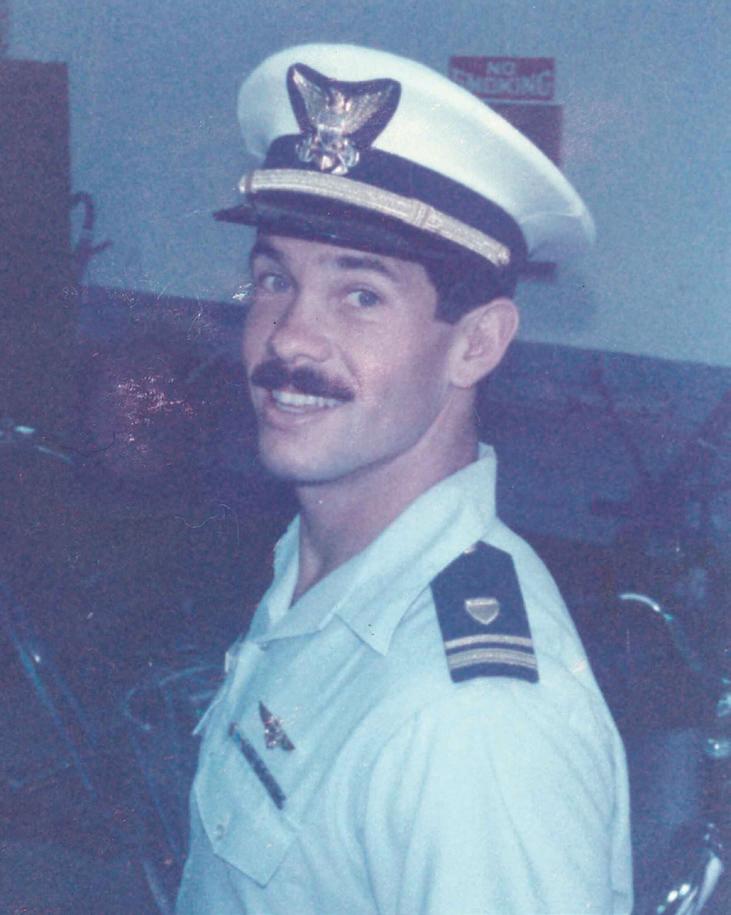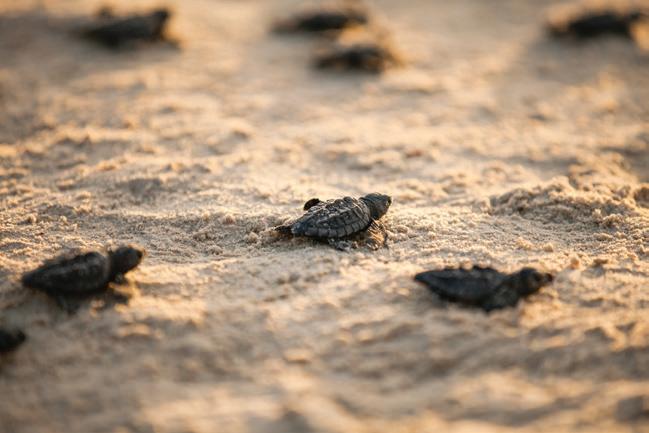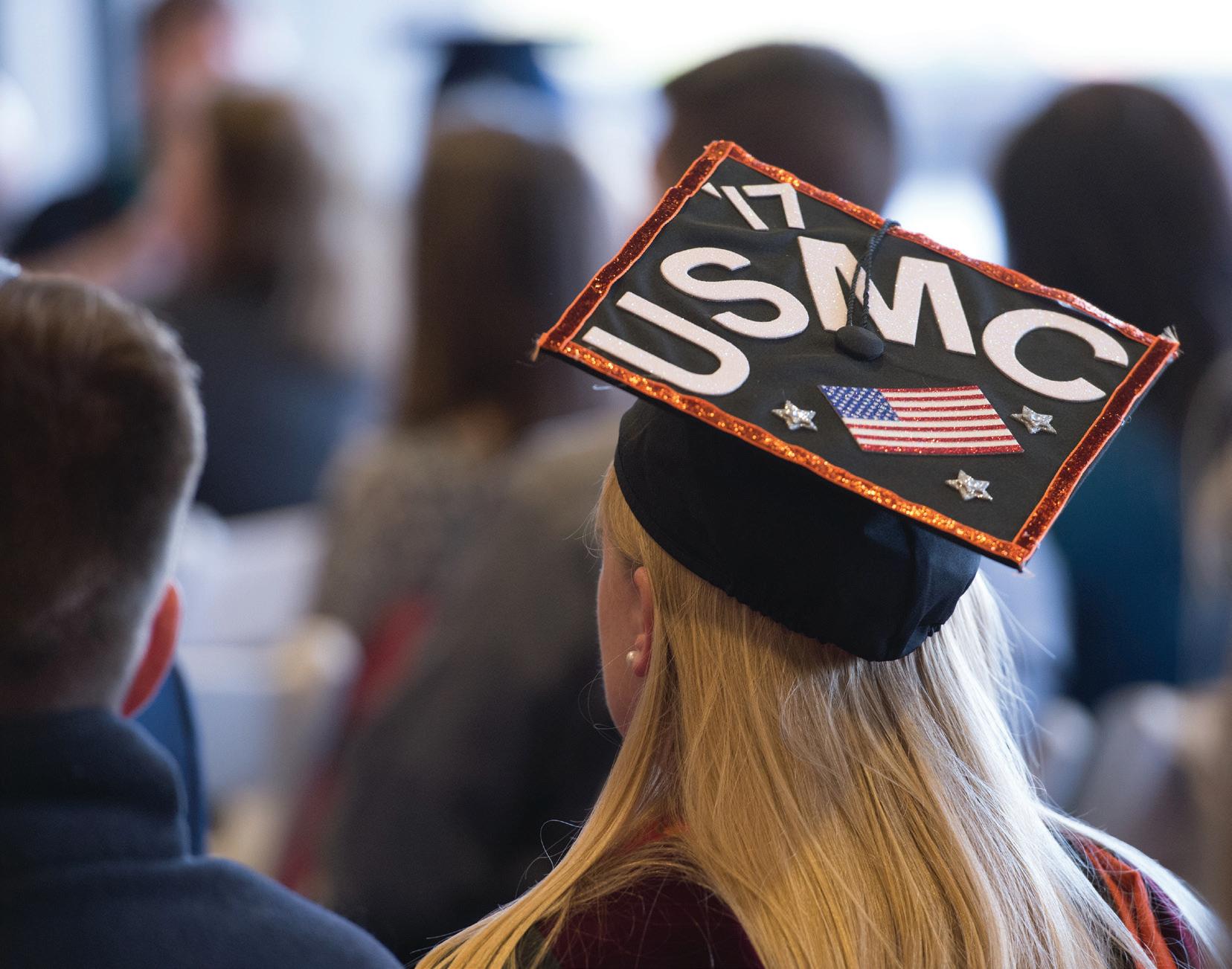
by AMERIFORCE MEDIA, LLC AUGUST 2021 Return to class PREPPING FOR SCHOOL TRANSITIONS THIS FALL WARRIOR GAMES PREVIEW USING TA TO SUCCEED updates gi bill MADE FOR THOSE WHO LOVE THEIR STUFF USAA RENTERS INSURANCE Visit usaa.com/renters Membership eligibility and product restrictions apply and are subject to change. Renters insurance provided by United Services Automobile Association, USAA Casualty Insurance Company, USAA General Indemnity Company, Garrison Property and Casualty Insurance Company, based in San Antonio, TX, USAA Limited (UK) and USAA S.A. (Europe), and is available only to persons eligible for P&C group membership. Each company has sole financial responsibility for its own products. © 2021 USAA. 278451-0521

Insured by NCUA. 1Credit and collateral subject to approval. 2Message and data rates may apply. Visit navyfederal.org for more information. © 2021 Navy Federal NFCU 13884-A (1-21) Car Loan Decisions in Seconds We can help you save on a new or used car with a Navy Federal car loan.1 • Great interest rates • Fast approval process • Low monthly payments Easily apply with our mobile app,2 online or at your local branch. navyfederal.org/auto
Iwill never forget the day in March 2020 when I tried to process the news that my children’s school would become virtual for the remainder of the year. It felt unimaginable, and I admit to shedding more than a few tears while stressing about how we would manage. Little did I know this “new normal” for education would last a lot longer than just three months.
Some parents, like Jaime Austin, whose husband is a masterat-arms in the Navy Reserve, decided to enroll her sons in a private school because it reopened for in-person instruction the following fall. She discusses her choice in our “Return to class” story.


While researching the cover feature, writer Kristen De Deyn Kirk also asked experts for tips on smooth transitions as more
Laura Adams Boycourt
Emma Comery
Kaitlynn Copinger
Rich Dolan
students get ready to return to the classroom in a few weeks. We love the article’s advice to “adapt to where our students are” and not treat them like they are behind. Get more tips that will set your family up for success this year on page 8.
The learning continues in our back-to-school issue with a report on Florida’s implementation of the Purple Star School Program, GI Bill benefit updates, and a testimonial on the importance of using TA.

Stacy Allsbrook-Huisman
Kristen De Deyn Kirk
Pamela McBride
Jessica Manfre
@MilitaryFamiliesMagazine
@militaryfamiliesmagazine
@MilFamiliesMag
Our pages this month also offer you a Warrior Games preview, news on the Brandon Act, and my Rapid Fire interview with Olympic boxer and Army Staff Sgt. Naomi Graham. You will want to flip to our back page to find out her thoughts on enduring repeated punches and a super strict diet while training for the Tokyo Games.
In “Every Little Step” Army spouse Pamela McBride offers a relatable essay about making the best of the realities of military life and marriage.
No matter what happens during school this year, my mission is to make the best choices possible for my family and remind myself that the most important lessons often come from seemingly impossible circumstances.
Happy learning.
Melissa Stewart Content Editor

ON THE COVER
Portrait of elementary school student Bodhi
Austin by Skylar Wyatt Photography
www.militaryfamilies.com | 3 LETTER FROM THE EDITOR
contributors
My kids and me, all smiles, on the first day of what we thought was going to be a typical school year.
Our cover model Bodhi Austin participating in virtual school at the beginning of the pandemic.
by Kristen De Deyn Kirk
by Melissa M. Stewart
Military Families Magazine by AmeriForce Media, LLC, is published 12 times a year for active duty service members and their families. Copies are available through participating family service centers, relocation offices, transition offices, base lodges, libraries, daycare centers, MWR activities and other locations by request. Unit requests can be made online at https://militaryfamilies.com/ print-magazines/
Individuals can order a free digital copy of this issue at https://militaryfamilies.com/digital-magazines/ Editorial comments can be emailed to managing.editor@ameriforcemedia.com

Military Families Magazine is published by AmeriForce Media, LLC, Bloomington, Indiana, a private company. Information and advertisements in this publication do not constitute endorsement by any branch of the military or the Department of Defense. No part of this publication may be copied without the express written permission of the publishers. AmeriForce Media, LLC, the publishers, and publisher’s agents make no endorsement of any advertised services or products and none should be inferred.
by Jessica Manfre
by Emma Comery by Laura Adams Boycourt
President and Publisher Todd Taranto
Managing Editor Bianca Strzalkowski
Content Editor Melissa Stewart
Design Open Look Business Solutions


ADVERTISING
PLEASE CALL 703-337-8100
Todd Taranto Publisher
Todd.Taranto@AmeriForceMedia.com
Julie Miller Vice President, Sales Julie.Miller@AmeriForceMedia.com
AmeriForce Media, LLC 205 N. College Avenue, Suite 450 Bloomington, IN 47404 https://ameriforcemedia.com
4 | www.militaryfamilies.com
Contents
Printed in the United States. ©2021 AmeriForce Media, LLC EDITORIAL AND PRODUCTION 20 Coastal Bend Warrior Games 2021 26 Coast Guard vice commandant reflects on lifetime of service 16
Return to class — Prepping for school transitions this fall 08 The Brandon Act gets reintroduced in Congress 06
AUGUST 2021 ISSUE














































Get your discount today. Michelle McKinstry Military Spouse “I made sure to let everybody know that GEICO was willing to help when other insurance companies weren’t. Many people in my husband’s unit switched to GEICO right then.” geico.com | 1-800-MILITARY | Local Office Military Discount for Heroes Like You Some discounts, coverages, payment plans and features are not available in all states, in all GEICO companies, or in all situations. GEICO is a registered service mark of Government Employees Insurance Company, Washington, DC 20076; a Berkshire Hathaway Inc. subsidiary. © 2020 GEICO
The Brandon Act gets reintroduced in Congress
BY MELISSA M. STEWART
One military family isn’t giving up the fight to get a bill passed that would help service members with suicidal ideations get immediate and confidential help — no questions asked.
Patrick and Teri Caserta said they are determined to honor the legacy of their son, Brandon Caserta, a sailor who took his own life in 2018 while stationed at Naval Station Norfolk. After first being introduced last year by Sens. Seth Moulton and Martha McSally, the Brandon Act failed to make it to a Congressional vote. But the Casertas say they are even more hopeful that the legislation will become law the second time around. The bill was reintroduced on Capitol Hill in June.

“The bottom line is we’re killing our own,” said Patrick, a retired Navy recruiter, on the afternoon before he planned to travel to Washington with his wife for a press conference announcing the reintroduction of the bill.
“When everybody understands this, a light will go on in their head, and they will say, ‘You know what, somebody needs to do something about this.’ And we need to unite to do it. We have no more children, so this is for America. We just want to make a difference.”
The Casertas first got inspired to initiate change after reading notes left by Brandon that claimed he experienced a pattern of verbal abuse and bullying from his petty officer and members in his command. Brandon indicated that he felt like he had nowhere to turn for fear of additional hazing and retaliation. The Brandon Act’s mission is to make it safe and accepted for service members to receive mental health services. A safe phrase would trigger an immediate referral.
“Every American, especially our heroes in uniform, deserves mental health support at work,” said Moulton at the reintroduction press conference. “Brandon deserved that, but we let him down.”
According to the DOD Quarterly Suicide Report (QSR), for the first quarter of 2021, there were a total of 115 suicide deaths including active duty, reserves, and National Guard members.
Patrick said while he recognizes bills are hard to get passed, he
6 | www.militaryfamilies.com IN THE NEWS
Teri and Patrick Caserta with their son, Navy Aircrew Electrician’s Mate Striker Brandon Caserta, after Brandon’s boot camp graduation.
feels confident that the Brandon Act will be able to spur necessary change.
The bill is now sponsored by LULAC (League of United Latin American Citizens) as part of the Save Our Servicemembers (SOS) Campaign that highlights the importance of safety in the military ranks. Additional lawmakers who have shown support include sponsor Sen. Mark Kelly, Rep. Debbie Lesko, Rep. Mark Takano, and many more, including 10 House sponsors as of late June.
Patrick says Brandon would be proud of his and Teri’s commitment to the Brandon Act.
“He truly cared about people,” said Patrick. “This is his legacy

and what he would want, and if I remember correctly, in one of the letters that he left, he put in there that, ‘I hope things are already better in the command.’ I truly believe that he sacrificed himself to bring attention to the problem.”
The Casertas predict they will find out the fate of the Brandon Act by November. Teri advises military families not to give when trying to garner the support of lawmakers and incite important changes that they believe in.
“They just need to be persistent,” she said. “They have to be adamant. The squeaky wheel basically gets the grease. They have to ask their lawmakers for what they want. Don’t be afraid to ask.”
Teri Caserta says that military families interested in showing support for the Brandon Act (H.R. 3942 and S. 2088) should contact their state legislators and let them know that they support the bill. She created a petition that will generate a letter to go directly to representatives and senators based on zip code.

More information can be found at thebrandonact.org and on Facebook and Instagram @thebrandonact

www.militaryfamilies.com | 7
“I truly believe that he sacrificed himself to bring attention to the problem.”
—Patrick Caserta
The Casertas with Brandon Act sponsors Sen. Seth Moulton and Rep. Debbie Lesko.
Lawmakers speak on behalf of the Brandon Act during its reintroduction to Congress in June.

8 | www.militaryfamilies.com BACK TO SCHOOL
PHOTO BY SKYLAR WYATT PHOTOGRAPHY
Prepping for school transitions this fall
BY KRISTEN DE DEYN KIRK
In spring 2020, Bodhi Austin, a now 5-year-old from Virginia Beach, didn’t understand why he couldn’t go to school, play sports, or see his friends. In hopes of easing his isolation, his mother, Jamie, returned Bodhi and his younger brother, Finn, to their private school as soon as it re-opened in the fall.
Both boys were happier, but still struggled. Masks made it impossible for them to see their new teachers’ facial expressions. Was she happy, frustrated, upset? They also couldn’t always hear their teachers.
“It’s hard to feel comfortable with a new teacher under those circumstances,” said Jamie Austin, whose husband, Petty Officer 2nd Class Lee Austin, is master-atarms in the Navy Reserve.
More students return to class this year, and parents are anxious about a smooth transition back. Anne Inwood, who holds master’s degrees in child development and social work and owns Successful Families Together in the Chicago area, recommends parents take three steps:
1. Communicate: Talk with your child about their feelings and concerns. For a long time, they’ve heard how it is unsafe to be in groups. Help your child learn about new recommendations and how you feel about them.
2. Look for changes in behavior: “Some, as they become more stressed, tend to retreat inside,” said Inwood, “and you may not see as many outward behaviors. Others become more disruptive. These children are often noticed first, but this does not mean that both groups don’t require more attention.”
3. Spend time together: Increase the amount of time you’re with your children and provide more love, support, and comfort.
First, though: Parents must calm themselves. Educators want parents to lessen their worries about their children adjusting to in-person learning again and supposedly being “behind.”
“It’s important to remember that interrupted schooling is not a ‘new’ phenomenon,” said Chris Chang-Bacon, Ph.D., assistant professor in the department of curriculum, instruction, and special education at University of Virginia and author of “Generation interrupted: Rethinking ‘students with interrupted formal education’ in the wake of a pandemic ,” published in Educational Researcher in February 2021.

www.militaryfamilies.com | 9
Researchers have studied immigrant and refugee students who faced interrupted learning for decades, applying lessons learned to them and other similar students. Educators can rely on this knowledge now to benefit all children. Chang-Bacon notes that the following tactics are ideally being used by schools:
• Giving teachers the freedom to adapt curriculum to students’ specific needs and strengths
• Calling on special education teachers, English as a second language teachers and veteran general education teachers with expertise on differentiating curriculum to assist other teachers
• Elevating the voice of teachers and counselors who have knowledge in helping long-absent students transition back into schooling
• Encouraging parents to support administrators and teachers by giving them flexibility with the curriculum and funding to do so
• Focusing on what students have learned formally and informally and how they’ve processed the dramatic changes
• Stressing the damage of “we’re behind” thinking.
“We know from research that treating students as ‘behind’ is unproductive,” said ChangBacon.

“Since school-age kids are at a crucial stage of identitydevelopment, they internalize the messages they hear directly and indirectly. If you treat a kid like something is wrong with them, they’ll believe you. They’ll absorb and internalize that anxiety about ‘learning loss’ that’s all around them.”

Chang-Bacon likes to ask, “behind what?,” noting that administrators create educational standards as tools to establish a general idea about what students should cover. But when major changes occur, like a global pandemic, it’s appropriate to rethink the benchmarks.
“At the end of the day, educational standards are relatively arbitrary,” said the educator-researcher. “We really do have the power — even a duty — to adapt to where our students are.”
Jamie tweaked her own instruction after she suspected that Bodhi had ADHD and his doctor confirmed it. She also noticed Finn was ready for more advanced work. (Both are noteworthy accomplishments as she was pregnant and later caring for now 1-year-old Jolie.) She considers having her eyes opened in these two ways benefits of the pandemic and trusts the boys’ school to adjust and build on the progress she helped them make.
“They will continue to do what is best for all the students,” she said.
Rachel Moon, M.D., division head of general pediatrics at University of Virginia and a former Air Force physician, is clear about her support of vaccinating children against COVID:
“I’ve been in the community, volunteering giving shots,” she shared. “It’s one of the most important things I’ve done in my life.”
Children want the vaccine, she said. They want to be in school and get back to sports. They only worry if they fear needles. Many parents are on board, too — although they ask for more data.
“But we have lots of data from the CDC,” Moon said. “We’ve given hundreds of millions of doses now, and it’s highly effective and very safe. It’s probably one of the safest vaccines out there.”
She anticipates children younger than 12 possibly being able to receive the vaccine in the fall, if reports about Pfizer’s progress are correct.
What percentage of families will rush to vaccinate their young children remains to be seen. This summer, some parents of college students still debated the option, even though they’d had months to get it. Universities then announced mandates for student vaccination, and some, knowing of a growing hesitancy, got creative.
“One University of North Carolina campus offered a contest and handed out Starbucks cards. University of Arizona offered gift cards; and Illinois’ Danville Community College offered a tuition waiver for summer courses,” said Phil Ollenberg, an assistant registrar at Bow Valley College in Calgary, Alberta, who tracks trends in American higher education.
“It’s too early to measure efficacy [of the incentives], but it’s part of a broader scheme to encourage herd immunity to protect campus communities.”
10 | www.militaryfamilies.com BACK TO SCHOOL

‘EVERY LITTLE STEP’
THE SONG THAT’S THE STORY OF OUR LIVES
 BY PAMELA M. MCBRIDE
BY PAMELA M. MCBRIDE
12 | www.militaryfamilies.com FIRST PERSON
I’ve run a lot of races in my lifetime. But there was one race I dreaded deep down in my soul: the Army TenMiler. I had already run 13 miles in a half-marathon, started a hometown running group, and coached others to meet their fitness goals. Yet, there I stood wishing I had better prepared. But it was too late and there was no turning back. Thank God I had the epitome of a teammate in my husband, Doug, who promised it would be our race, our pace. And I trusted him.
As we ran through historic Washington, I strolled down memory lane, thinking about all the races of the military lifestyle we’d run over the past 31 years, determined to finish together, no matter what. Who knew that we would be facing the most difficult race of our lives right after we exchanged vows and promised each other in our wedding song: “every little step I make, we’ll be together?”
We started that marathon as two naive kids with no idea what twists and turns were coming around the bend. I thought we’d start off fighting about how to live together. You know, the important stuff like the toilet seat, the toothpaste cap, and how to load the dishwasher my way — the right way. Instead, we were blindsided by trying to figure out how to live apart and how to deal with the realities of a war we NEVER saw coming.
With no email, social media, or cell phones back then, my best hope for talking to my soldier was catching his call on the house phone, which was rare and unpredictable. In the first six years of our marriage, we were forced to live apart more than we lived together.
So, we were thrilled when we could finally live under the same roof and do things couples do ... like have children. We also bought our first house, by fax
machine while he was in Korea, moved four times in seven years, earned two master’s degrees, and finally got to fight about the toilet seat, toothpaste cap, and the dishwasher.
Our next big race came when Doug neared retirement and we bought our forever home in Georgia. Our grand plan was for him to leave without us for his final two-year assignment while the kids and I established roots in our new community. Then, he would retire, come home, and we’d live happily ever after. Instead, he didn’t retire after those two years. The kids and I spent the next 11 years in Georgia, while Doug lived in some other state, and sometimes in a whole different country.
After all those years of hating that we were forced to live apart, here we were, choosing to live apart ON purpose, but FOR a purpose. We didn’t want our kids to move every year or two like most military kids. Our first child had already moved six times by the time he was 7 years old. Living separately was a choice, but that didn’t make the race easy.
In fact, it was an emotional roller coaster ride that our family took every weekend. Doug drove back and forth to home because we were hell-bent on being together as much as possible. At times, there were strained conversations and differing opinions about how the weekend would go.
For example, the minute Doug got home he walked through the entire house and every inch of the yard. This made me want to pull out my hair. Until one day I said, “PLEASE, NO inspections this week!”
He frowned, surprised. “I’m JUST trying to see what repairs I need to plan for, and which repairs need attention right now.”
“Really? Well, let me help you out. I need attention right
now! To hell with the house. It’s not going to fall apart, but I might!”
My brutal honesty changed the whole course of that race.
The final race that took us into the homestretch was our time as honeymooning empty-nesters.

When our daughter started college, not only were the kids out of the nest but so was I. I packed up and flew the coop to Fort Hood. I admit though, I teetered back and forth between the absolute excitement of being with my husband again and being depressed about not being with my baby girl anymore. We’d been side-by-side. 24/7. For a long time. And then we weren’t.
Work and military events kept me and Doug busy during the week, and then we did fun things together on the weekends, like the Army Ten-Miler, with 35,000 of our closest friends, but running our own race, just as we always had. Over the past 31 years, we had completed every single mission. And even though his slowest pace was
faster than my fastest pace, we were determined to run our race together.
As much as I dreaded the Army Ten-Miler like I dreaded each deployment and every move that kept us apart, looking back I know that being prepared was just a small part of our team’s success. The bigger parts of our success were how we defined it.
Being on the same sheet of music about how we would run our race; and making good on our promise to each other, in the wedding song we chose: “Every little step I take, you will be there. Every little step I make, we’ll be together.”
Pamela McBride, an Army spouse for 32 years, is dedicated to improving military family life and veteran and military spouse employment. She is a senior advisor to a director of Equity, Diversity, and Inclusion in a federal agency. McBride has been a freelance writer for nearly 30 years, currently focused on telling her stories through personal essays. Last year, she and her husband returned to their forever home in Georgia.
www.militaryfamilies.com | 13
IMPARTS VALUABLE
CREDIT LESSONS FOR TEENS


 BY KAITLYNN COPINGER
BY KAITLYNN COPINGER
14 | www.militaryfamilies.com MONEY
Dionne Perry
Not your Social Security number. Not your cell phone number. And not your birthdate.
No, when you’re an adult, the most important number in your life is your credit score, says Dionne Perry, an Atlanta-based author and military spouse.
Your credit score, which indicates your creditworthiness, or how likely you are to pay money back on time, “affects everything.”
“You can’t do anything without good credit,” she said.
Perry’s first book, “Credit-Lit: Credit 101 for Teens,” provides easy-to-understand information about credit and credit scores, aimed at putting teens on a path to developing good credit.
“I’m really on a mission to educate as many youth, teens that I possibly can on the importance,” Perry said. “And hope that this may change their lives as they become adults.”
“And it could potentially also change the family legacy,” she added.
Self-published in February through Instill Publishing, the book provides teen-friendly advice about a topic that has intrigued Perry for 20 years. Perry, who works full time for a federal agency, says the pandemic gave her extra time to focus on achieving a long-time personal goal: to write a book about how to create and maintain good credit.
Her interest in credit scores is deeply personal. As a college student, she was inundated with pre-approved credit card offers. But, like many people, she wasn’t always able to pay her credit card bills on time. At the time, she didn’t understand the negative repercussion that would have on her credit score.
That is, until she tried to get a car loan and was denied.
As Perry began the long journey to repair her credit, she started to learn more about credit scores and credit history. She became a board-certified credit consultant and briefly worked as a licensed mortgage broker.
The lessons she’s tried to impart to her family and friends — and four now-adult children — is that a bad credit score can affect your employment, your ability to sign up for utilities, “almost every financial decision.”
Bad credit information stays on your credit report for seven years. It’s possible to repair a bad credit history; Perry did it. But it’s hard, and it takes a long time. That’s why Perry’s focus with “Credit-Lit” is prevention.
“I think if we start having early conversations, we’ll have less people who are trying to repair their credit,” she said.
The 64-page book is written in a way to appeal to teens, using a question-and-answer format.
Along with her book, Perry has also developed a Credit-Lit Ambassador program, empowering adults and teens to spread the word about the importance of good credit.
Her book is available on www.creditlit.com for $9.95, as well as through Amazon, Barnes & Noble, and other online book retailers. Perry, whose husband served in the Navy for 20 years and retired in 2009, said military families can get a 10% discount when purchasing the book through her website by using the code “military10.”

www.militaryfamilies.com | 15
When you’re an adult, it’s the most important number in your life.
Coast Guard vice commandant
reflects on lifetime of service
BY JESSICA MANFRE
“It became very apparent to me that if I was going to go to college, I was going to have to figure out how to do it,” said Ray.
“With the help of a Junior ROTC instructor, Sgt. Harold Francis Gay, Jr., - God rest his soul - he said, ‘Charlie, you can get one of these scholarships,’ and he helped me apply to everything.”
Known lovingly as “Sarge,” this mentor was a 22-year
Army veteran with combat deployments to both the Korean and Vietnam War zones. He and his family made their home in a small town in Arkansas, and Sarge co-founded the Junior ROTC program that Ray joined.

Applying to everything meant all of the military academies. “I got lucky and got the Coast Guard Academy. The first time I ever saw the Coast Guard I was in it,” Ray said with a laugh.

16 | www.militaryfamilies.com TRANSITION
Despite eventually earning a fourth star as second in command of the United States Coast Guard, a long career wasn’t always Adm. Charles Ray’s goal. As he prepared to hear “fair winds and following seas” after 40 years of service, the vice commandant shared his story.
Adm. Ray becomes the 31st Vice Commandant of the United States Coast Guard.
PHOTO BY PETTY OFFICER 1ST CLASS PATRICK KELLEY
He planned to finish his commitment to the Coast Guard and then head back to Arkansas. Ray said that he thought about becoming a marine inspector and working the Mississippi River along his hometown. He became a pilot instead.
“My dad was a Marine Corps aviator. He was in the reserves all the time I was growing up and did a couple tours of active duty when I was little. He’d go to Memphis to drill and he’d fly over our hometown. Back then, everyone knew that was my dad flying over,” Ray said. Although he loved aviation, the service time commitment that accompanied flight school was something Ray said he wasn’t sure he was ready for at 22 years old.
His first year out of the academy, he was assigned to the Coast Guard Cutter ACUSHNET (WMEC-167) as a deck watch officer in 1981. It was there that he fell in love with operations. “We did hurricanes; I was a boarding officer on a couple of drug busts and all of the amazing stuff that coasties do,” he explained.

Early on in his tour aboard the ACUSHNET, Ray witnessed a medivac and the experience left a lasting impact on him, he said. A few weeks after the incident Ray was on a dependents cruise as he watched a Coast Guard

helicopter fly around the cutter for families. “I remember looking at that thinking those guys are the best in the world at what they do,” he said.
His skipper saw him eyeing the helicopter and said, “Charlie, you can do that,” he shared. That moment led Ray to put a package in for Naval Flight School. “Next thing I knew, I was in Pensacola,” he said.
After earning his wings in 1984, Ray accumulated more than 5,000 hours of flight time. Before announcing his retirement, he was the longestserving aviator — the Coast Guard’s 25th Ancient Albatross. A humble man, Ray said he was never “super smart” or able to do it all on his own. Instead, he credits his successes to the mentors he had in his corner.

On May 24, 2018, he was sworn in as the 31st Vice Commandant for the Coast Guard.
“It’s been like that all along the way. People have helped steer

me and encouraged me. That’s why I’m still here,” Ray said.
“I think the Coast Guard is much more appreciated by the nation and much more respected than when I came in ... and the level of coasties that we have today is unbelievable.”
Ray isn’t leaving the Coast Guard too far behind in his rear view. He accepted a part-time position at the Coast Guard Academy working within the Loy Institute for Leadership. But before he digs into his role, he’s got big plans.
When Ray’s father retired, he asked him what it was like. His response is a phrase he plans on living by for this next chapter of his life: every day is Saturday “We bought a camper and we’re going to hit the road. I’ve got a lot of fishing to catch up on,” he said.
His advice to the new coasties starting their journey is simple.
“Do something that you really believe in and work with people you really care about … it doesn’t get much better than that.”
www.militaryfamilies.com | 17
Adm. Ray (far right) hands over the reins as Ancient Albatross. PHOTO COURTESY OF UNITED STATES COAST GUARD
What you need to know about new
Some recent changes will affect how one of the military’s most valuable benefits can be used — and who qualifies for them.
In January of 2021, Congress passed Public Law No: 116-315, putting into law a multitude of updates to veterans benefits, including 32 provisions impacting the GI Bill. Among the most impactful of the changes, veterans who have used their Veteran Readiness and Employment benefits will no longer lose their GI Bill benefits as a result. This will have widespread implications for veterans who used VRE benefits for a service-connected disability but are still seeking education assistance from the GI Bill.
Another big change helps those who were negatively impacted by COVID-19. If a GI Bill
BY RICH DOLAN
beneficiary was attending an educational institution that was closed between March 1, 2020, and Dec. 21, 2021, they’re eligible to receive up to four weeks of their Monthly Housing Allowance (MHA). Additionally, GI Bill benefits will be extended 661 days past the original expiration for veterans who experienced a temporary disruption in education due to the pandemic. There is also coverage for those who were forced to withdraw from their educational program due to illness or taking care of someone who was ill.

For those veterans who have been out of the military for more than three years and want to attend a public university outside of the state they live in, the non-resident tuition rate has always applied. Now, all GI Bill recipients will be charged the instate tuition rate when attending
these universities. Additionally, if an overpayment is made to the school by the VA, veterans will no longer be penalized. For recipients living abroad, the new law has also allowed foreign schools to participate in the Yellow Ribbon Program, potentially contributing up to 50% of a recipient’s tuition who is receiving the maximum GI Bill benefit.
The VA also has some technical programs that it covers through the GI Bill, including the Edith Nourse Rogers STEM Scholarship and Veteran Employment Through Technology Education Courses (VET TEC) programs, both of which saw changes in the new public law. The VET TEC program received an annual funding increase of $30 million, bringing their total annual budget to $45 million. VET TEC also extended eligibility
to service members who are within 180 days of separation. The Edith Nourse Rogers STEM Scholarship will now allow scholarships for students enrolled in dual secondary degrees — when one of the programs meets the program criteria — and health care professionals completing clinical training to become licensed to practice in a state or locality. The 48-month entitlement limitation on aggregate benefits and the 81-month entitlement limitation have also been eliminated for this scholarship.
These changes make the GI Bill and its many programs more accessible, as well as eliminate predatory practices by schools. GI Bill recipients won’t be penalized for disruptions outside of their control, making this benefit even more valuable to those who earned it.
18 | www.militaryfamilies.com BENEFITS

This lesser-known beach destination in southern Texas is bucket list-worthy
BY EMMA COMERY
Between the rolling expanse of Texas Hill Country, ranches, and the iridescent Gulf of Mexico, Corpus Christi and the surrounding Coastal Bend sit on the shoreline, offering a truly unique Texas getaway.

Coastal Bend includes the southern Gulf Coast region of Texas that starts in Rockport and curves down through Corpus Christi, then around to Port Aransas. From there, Corpus Christi spills out to sandy North Padre Island, where the brightly colored waterfront homes quickly give way to 60 undeveloped miles of National
Seashore, the longest stretch of undeveloped barrier island in the world.
It’s in this palm-tree-lined coastal paradise that Travel Advisor Rosemary Wynn chooses to vacation with her family each year. “I’ve been visiting Rockport my whole life,” she shares. Coastal Bend holds a special place in her heart, but why should travelers put this lesser-known destination on their bucket list?
“The Coastal Bend has so many unique things to see and do!” Wynn exclaimed.
“Visiting the beach, sailing, motorboating, fishing ... visiting unique breweries in Corpus, visiting historic sites like the USS Lexington, going to a minor league baseball game at Whataburger Field, crabbing, kayaking, paddle boarding, birding ... Rockport is a bird watcher’s paradise.”
With the Gulf on one side and the Laguna Madre on the other, Coastal Bend is one of the world’s most populated migratory bird destinations, and each year thousands of birders and tourists flock to Port Aransas for the Whooping Crane Festival “Aransas National Wildlife Refuge is one of the best places in Texas and possibly the world to see all types of birds,” said Wynn.
But heading out into the preserves with a pair of binoculars is like dipping a toe into the veritable whirlpool of outdoor excursions the area has to offer.
Coastal Bend culture is the very definition of “work hard, play hard,” with a nonstop lineup of festivals, farmers markets, music concerts, and watersports for locals and visitors alike to enjoy.
In fact, some of the most memorable Coastal Bend excursions can be found offshore. The Texas Gulf Coast is a mecca of deep-sea fishing, and booking a day charter with a local guide is a must-do Coastal Bend experience.
20 | www.militaryfamilies.com TRAVEL
PHOTOS COURTESY OF
WWW.VISITCORPUSCHRISTITX.ORG
Wynn paints a picture of her perfect South Texas weekend. “Going out on a fishing trip with our guide,” she begins, “Then cooking our catch or taking it to a local restaurant to cook for us, kayaking around the bay, possibly visiting Rockport Beach, or going for a sunset cruise.” No trip to Rockport is complete, however, without happy hour at Glow, says Wynn, a charming coastal kitchen inside an old sailboat repair shop. The ocean-friendly restaurant is known for serving mouthwatering seasonal dishes and house cocktails on an intimate covered porch overlooking the bay.
Located within driving distance of both Mexico and New Orleans, Coastal Bend boasts a food scene


rich in South Texan, Mexican, Cajun, and even Asian influences. Not only does the area offer out-of-this-world seafood and barbecue, but some of the best Indian food in the country can be found at Pavani Express, a tiny family-owned restaurant in the back of a Citgo gas station in Corpus Christi.
But the beauty of Coastal Bend is that the best views don’t come from rooftop bars or luxury hotel balconies. They come from the beaches. Travelers looking for a truly beachy experience should consider camping on the beach at Padre Island. Grab takeout from one of the island restaurants ( The Angry Marlin for fish tacos, Costa Sur for ceviche, or Surfside



Sandwich Shoppe for Cubans and coleslaw) while watching the sunset, then wake up to some of the most dazzling sunrises in the country.
In Rockport, The Copa Copa is a family-owned luxury RV campsite that offers the ultimate coastal glamping experience. Each site comes with a private patio, and guests are just steps from the private fishing pier, mini beach, and dipping pool overlooking the Copano Bay in Rockport. And in Port Aransas, Camp Coyoacan, or “Place of Coyotes,” offers nontraditional lodging in the form of gorgeously appointed tent cabins and yurts just three minutes from the beach.
One of Wynn’s favorite Coastal Bend memories was attending a sea turtle release at the National Seashore. “The Padre Island National Seashore is one of the most beautiful beaches anywhere,” she raved. “In the summers, the public can witness Kemp’s Ridley Sea Turtle hatchlings being released at the beach, but only if they’re committed to showing up at sunrise. The early wake-up is worth it, though, Wynn promised.
“One year we witnessed the release of 100 baby sea turtles in honor of the 100th anniversary of the National Parks System. It is an amazing experience.”

www.militaryfamilies.com | 21
PURPLE STAR SCHOOLS FINDS A HOME IN THE SUNSHINE STATE
 BY STACY ALLSBROOK-HUISMAN
BY STACY ALLSBROOK-HUISMAN
22 | www.militaryfamilies.com
INITIATIVE
Florida State Rep. Andrew Learned, co-sponsor of House Bill 429- Purple Star Campuses.
Jennifer Southerland, a committee member of the Florida Parent-Teacher Association, attributes her optimistic outlook to the passing of legislation that will directly support military kids in school.
“The passing of the Purple Star Campuses Bill this year is very exciting because I think that is has the potential to help all schools who choose to participate to put more thought, consideration, and action into successfully helping ease the transition of all militaryconnected students and families,” Southerland said.
Southerland is referring to Florida’s passing of House Bill 429- Purple Star Campuses. The bill was sponsored by Rep. Andrew Learned (D) and Rep. Patt Maney (R) and passed with bipartisan support. It established the Purple Star School program, which helps schools support educational and social-emotional challenges military-connected children face during school transitions.
Florida’s program recognizes schools that offer specific opportunities and resources that directly support military-connected students. Requirements include having a designated point of contact for incoming military families and a school website with information and resources for military families. In addition, schools provide a student-led transition program and professional development for educators on the education and emotional challenges of military kids. The bill also requires a designated school to reserve at least 5% of open enrollment seats for military-connected students.
Kim Sukach understands the need to support military families through school transition. She has the unique role of being the district liaison for military families in Hillsborough County Public School (HCPS) in Tampa, Florida. Sukach, a former educator, works for HCPS and partners with local school liaison officers to support military families in the area. HCPS is the 7th largest school district in the nation and has one of the highest military populations in the state. She supported the passage of Purple Star Campuses and looks forward to helping HCPS schools implement the designation.
“It is a great opportunity for schools that do so much for their military populations to be recognized for their effort,” Sukach said.
“As educators, we jump to the academic needs of our transitioning students and overlook the role friendship and peer interaction have on the social-emotional well-being of our military students. On the first day in a new school, the anxiety comes from worrying about not having anyone to eat lunch with; it’s not about school supplies or schedules. That is why the student-led transition program is so important for all students.”
The Purple Star School program isn’t necessarily new to schools around the country, but it is new to Florida schools. The Purple Star School designation is the brainchild of Pete LuPiba, Ohio’s commissioner for Military Children Interstate Children’s Compact Commission (MIC3). LuPiba, a Navy veteran, wanted to create additional ways for
schools in Ohio to support military kids. In 2016, he gathered community leaders and those most invested in the militaryconnected students to discuss the best way a school could show its commitment to military families, and the program was born.
Since its inception, Ohio now has more than 400 Purple Star Schools and is growing each year. But more importantly, 30 other states have implemented some form of the Purple Star School program. LuPiba hopes it continues to catch fire.

“My sincere hope is Purple Star from sea to shining sea,” he said. “There are real people behind this substantial movement. I commend each veteran and educator for being purposeful, strategic, and leading by example.”
Southerland is excited for military families moving into Florida because of the passing of the bill but thinks schools may benefit the most.
“I truly hope that schools will see that this really benefits the school too, not just the families,” she said.
“The more education regarding military transition challenges, the more seamless the transition and the less disruption there will be overall. When staff know how to assist and support military families, both academically and emotionally, learning gains are more likely to occur.
Military parents should be seen as a valued resource when bringing in their experiences from all over the world. Their children are global thinkers and they are usually the kids who get involved quickly because they know time is of the essence.”
To find out more about Purple Star Schools and how to help start a program in your area, visit www.militarychild.org/ purplestarschools.
www.militaryfamilies.com | 23
Before schools in Florida wrapped up an unprecedented and difficult year of learning, one mom and education advocate was already cheering for the start of the next school year.
Jennifer Southerland with her daughter Scarlett celebrating Purple Up at a local elementary school in Florida.
TA HELP MILITARY STUDENTS
UNIVERSITY SUPPORT SYSTEMS, SUCCEED
BY RICH DOLAN
One dual student and soldier says his decision to use TA benefits was simple.
“I don’t think opting to use TA benefits was a difficult choice at all; getting a degree can be expensive, especially depending on the school you choose to attend,” said Sgt. Mgr. Timothy White, an Army Senior Healthcare NCO with 4th Security Force Assistance Brigade (SFAB) at Fort Carson, Colorado.

“Every little bit helps, and I don’t see why anyone would opt out of using these benefits.”
White chose to pursue his Master of Business Administration (MBA) with a concentration in finance at Syracuse University due to the marketability of an MBA and the salary it can demand outside of the military. He encourages other service members to take advantage of these benefits and points to
how simple they are to access. “Accessing the benefits is as easy as going to the local education center and talking to a counselor, then applying to the school and requesting the TA benefits online,” White said.
However, before committing to the TA program, White says that service members must do some self-reflection. “Anyone applying to a university program while working full time needs to do a good analysis of whether or not it
is feasible for them to accomplish the program and handle the rest of their life responsibilities,” White said.
Liz Green, executive director of Online Student Success at Syracuse University, works with service members like White every day. According to her, there are approximately 100 students in Syracuse’s part-time online undergraduate degree programs using TA benefits. Of those 100 students, 66%
24 | www.militaryfamilies.com HIGHER EDUCATION
PHOTO COURTESY OF SYRACUSE UNIVERSITY
National Veterans Resource Center at Syracuse University
are pursuing cyber security or creative leadership degrees, with the remainder following liberal arts paths. Green says the biggest issues that service members face when pursuing online programs are time management and connectivity issues, but the support system that Syracuse offers is often able to help in these cases. “We’re not 24/7, but we try to be flexible with students and their schedule,” said Green.
“We try to have a very intentional model of support that is as proactive as can be.”
Syracuse University also helps by adjusting their tuition so that anyone using TA benefits to pursue an online undergraduate degree program will be fully covered. Jessica Calhoun, assistant director for Veterans and Military Admissions at Syracuse University, is also available to all service members and veterans during their time at Syracuse. Calhoun points to Syracuse University’s building dedicated entirely to veteran and military student success — The National Veteran Resource Center. As a service member or veteran student, “You know
that there’s an entire brandnew program that’s dedicated to you and your success,” said Calhoun. Additionally, any employee at Syracuse who has experience and knowledge dealing with the military community has an orange sign that hangs from their door, inviting all military or veteran students to enter and ask for help.
The decision to use TA benefits is a personal one, but service members stand to benefit from it significantly — especially when applying to any college, university, or trade school with similar programs in place. If service members aren’t confident that they meet required prerequisites to pursue a degree, they should still reach out to the school of their choice to inquire.

“If a student isn’t confident that they’d meet the criteria for one of our programs, we’d like to speak with them anyway.” said Green.
Military accomplishments and schools often transfer into college credits, allowing service members to secure degrees even quicker. Learn more about TA benefits at your local installation education center.

www.militaryfamilies.com | 25
GOING FOR GOLD ON THE JOURNEY TO RECOVERY

The 2021 Department of Defense Warrior Games allows hundreds of active and veteran military members from the United States and international allied nations to compete in adaptive sporting events that demonstrate their drive to succeed and represent their country alongside fellow service members.
From Sep. 12-22, wounded, ill, and injured military members will come together at the ESPN Wide World of Sports Complex at Walt Disney World for this year’s installment of the Warrior Games. The event, which has been held since 2010, is hosted by the U.S. Army’s Training and Doctrine Command. Adaptive sporting events including wheelchair rugby, cycling, swimming, and wheelchair basketball.
For most participating athletes, the Warrior Games represent the result of months of recovery and training efforts. Travis Claytor, director of strategic communications for the games, explains that each U.S. service branch and Special Operations
Command (SOCOM) has a type of Warrior Care Program that organizes the games. The program provides resources to wounded, ill, and injured service members, both active duty and retired.
“What they found is that sports can play such a meaningful role in the recovery process for each of these military members, that they created an adaptive sports program so that they can stay engaged,” Claytor said.
Many of the men and women who take part in the adaptive sports were athletes before their injury or illness, and these opportunities allow them to stay active and competitive and work towards a new goal, he adds.
“The Warrior Games is simply the culmination of this journey through the adaptive sports programs through each of the Warrior Care Programs,” said Claytor.
“This really is a journey for them, and our goal is to serve as just one stop in that journey because it continues after the games.”

26 | www.militaryfamilies.com SPORTS
BY LAURA ADAMS BOYCOURT
U.S. Army retired Staff Sgt. Joel Rodriguez, wife Liannie, and son Elijah at the 2019 Department of Defense Warrior Games in Tampa, Florida.
PHOTO BY STAFF SGT. MICHAEL LOGGINS
Claytor says each service branch puts out a notice for Warrior Games tryouts. About 45 athletes make the team for each branch, with approximately 300-400 athletes total competing in the games.
A new chapter, a new goal
When U.S. Army retired Staff Sgt. Joel Rodriguez first watched a wheelchair rugby practice, he was in an electric chair and neck brace, just several weeks after a car accident that left him with a broken neck and severed spinal cord. Still, he knew at that moment that he wanted to be a part of the Warrior Games.
After intensive therapy and on the advice of his therapist, Rodriguez began training about eight months after his injury. “Life right away got busy,” he said. “I started playing rugby right out of the hospital.”
After an invitation to practice, Rodriguez joined a Warrior Care Program and fell in love with wheelchair rugby. It’s been full steam ahead ever since.
“I haven’t stopped,” he said.
As a participant in the 2018 Invictus Games, Rodriguez was no stranger to the training grind and intense competition, so he had an inkling of what was to come at his first Warrior Games in 2019. He says he expected to compete hard, and that expectation was realized.
Rodriguez competed in events including swimming, indoor rowing, and track and field and earned seven medals, five of them gold.
Rodriguez says the games are all about embracing the present and the future.
“Warrior Games is extremely important for the simple fact that it shows athletes or wounded veterans that after an injury, there still is life. It focuses on what you can do, not what you can’t do.”
Continuing camaraderie
Marine Master Sgt. Johnathan S. Rose is Wounded Warrior Operations Center chief of the Wounded Warrior Regiment, which assists wounded, injured, and ill Marines in remaining active duty or transitions to civilian life. Rose himself was severely injured by an IED while deployed to Afghanistan, sustaining injuries including multiple compound fractures, burns, and the loss of vision in one eye.
Over time, Rose challenged himself through
adaptive sports and participated in numerous competitions including three Marine Corps Marathons and the Valor Games
He says being part of the Warrior Games allows athletes to cultivate new bonds.
“It’s important to compete in the games because you’re back around like-minded people,” he said.
“The camaraderie and competition of the games is a culminating event in your recovery. Our fellow wounded, ill and injured
countrymen and women, who are finding their new normal, are able to fellowship in a way they normally can’t. I could fail at every sport, but I’m around my brothers and sisters who fell in the same dirt I did. They know a part of my life that others will never understand.”
Although COVID- and CDC-related guidance is everchanging, organizers expect to be able to welcome the public — free of charge — to cheer on athletes from the stands. For updated information, visit dodwarriorgames.com.

www.militaryfamilies.com | 27
Spouse council aims to address key issues for homebuyers
BY MELISSA M. STEWART
A new military spouse advocacy group hopes to build upon diverse backgrounds and varied experience to guide service members and veterans through the often-complicated process of home ownership.
The Caliber Military Spouse Council is made up of six spouses who are experts on military family issues like PCS reform, veteran homelessness, LGBTQ inclusivity, employment, Gold Star families support, and more. During a two-year term, they are tasked with learning about the unique needs and challenges of military homebuyers and then identifying services, resources, and potential community partners to help.

MILITARY SPOUSES 28 | www.militaryfamilies.com
The inaugural Caliber Military Spouse Council (from left): Megan Harless, Marla Bautista, Brian Alvarado, Jessica Manfre, and Krista Simpson Anderson.
“Caliber’s product is important, because as members of the military community, and users of the VA Loan product, it can be quite difficult, especially in a market like we’re in now, where many loans aren’t even going to be looked at when multiple offers are on the table,” said council member Brian Alvarado. “And it gives us an opportunity to address those issues directly with the lending organizations to try and come up with solutions. And work with the military community to give that American dream, to have that white picket fence.”
Caliber Home Loans is a full-service national mortgage lender that originates a variety of loan products, including the VA Home Loan, through several channels and transactions. The company’s inaugural spouse council includes Alvarado, an LGBTQ community advocate and Deputy Director of Workforce Development on the Military Spouse Team at Hiring Our Heroes ; Jessica Manfre, a licensed social worker and founder of the Inspire Up Foundation ; Gold Star spouse Krista Simpson Anderson, cofounder of The Unquiet Professional ; Marla Bautista, co-founder of the Bautista Project Inc. and leader in addressing homelessness; Verenice Castillo, founder and CEO of the Military Spouse Advocacy Network ; and Megan Harless, an expert on PCS policy.
All of the members of the council agree that they stand out for being subject matter specialists on several key concerns for military families.
“With this council, we all work different platforms,” said Harless. “And so it’s a way to bring all of those issues together and be able to work on them together and support each other.”
Alvarado says his mission with the council is creating educational tools geared toward military community members that teach
them how to prepare financially for home ownership and also to inform the lending community on the unique challenges that military families face. Anderson plans to focus on survivor benefits and preparing for the unexpected.
“I want to take the benefits of the VA Home Loan, put them next to a regular home loan, and see where we can kind of fill in that gap and provide them to possibly remarried spouses, children, and then parents. I just imagined my kids one day buying their first home and being able to come to Caliber, [and them] saying, you know, ‘Thank you for the sacrifice of your father.’”
Alvarado points out the significance of being part of the initial group.
“This is the first military spouse advisory council for a big corporation,” he said. “We have the ability to set an example, not just for a future Caliber Military Spouse Council but also for other companies who may want to look at this model and make it a priority as part of their corporate responsibilities.”

Bautista adds that the members are just as important as the council’s mission.
“I think for me, just knowing that the people that I work with, my friends, that these women and men are absolute fierce advocates for what they believe in,” she said. “And knowing that I’m a fierce advocate, coming alongside of that was a no-brainer. It was like, we absolutely have to do this. And I am naive enough to believe that we can change the world.”
For more information on the Caliber Military Spouse Council and its members, visit https://military.caliberhomeloans. com/caliber-difference/military-spouseadvisory-council/
www.militaryfamilies.com | 29
“This is the first military spouse advisory council for a big corporation. We have the ability to set an example, not just for a future Caliber Military Spouse Council but also for other companies who may want to look at this model and make it a priority as part of their corporate responsibilities.”
—Brian Alvarado
RAPID
FIRE
Q&A WITH OLYMPIC BOXER NAOMI GRAHAM
BY MELISSA M. STEWART
As if Olympic athlete status isn’t admirable enough, USA Boxing middleweight Naomi Graham also enjoys the distinction of being the first female active-duty service member to fight in the Games. We chatted with the Army staff sergeant two weeks before she was scheduled to compete in the Tokyo Olympics to find out how she was prepping — mentally and physically.

How did you react to hearing Tokyo 2020 was canceled due to COVID last year?
I told myself, you know, ‘I’ll just work on more things.’ There are always things to work on. There are so many different ways to throw a combination. It’s a lot to learn. The most difficult part was everybody being locked down. Gyms were closed. I had to run outside. I did a lot of hiking and body weight.

What is your diet like?
I stay as clean as possible. I do a lot of baked chicken, fish, quinoa, brown rice, a lot of fruit. My go-to drink is a mix of tart cherry, elderberry, turmeric, and ginger.
What is the most important way you prepare for a match?
Meditation is mainly what I do. A lot of people listen to music before their fights, but I actually sit there and meditate. I’m visualizing what I want to do and what I want to happen.
Has your military training been an advantage?
Yes through patience and resiliency. I feel like the Army makes you feel like no matter what, you get it done.
Do
you ever get scared before getting
into the ring?
In the beginning, I didn’t know what to expect my first fight. I was very nervous. Punches felt different in the beginning, but as you keep going and get to the international level, people think it hurts but it really doesn’t.
Have you thought about what it would feel like to win a medal?
I think I would probably break down crying in the middle of the ring. I really can feel that.
30 | www.militaryfamilies.com Read more about Naomi Graham at https://www.teamusa.org/usa-boxing/athletes/Naomi-Graham.
PHOTO BY NATHANIEL GARCIA







MADE FOR THOSE WHO LOVE THEIR STUFF COVER YOUR STUFF ANYWHERE1 WITH USAA RENTERS INSURANCE. For as little as 33¢ per day, 2 USAA Renters Insurance covers your personal belongings like military gear, 3 electronics and more. Even when it’s in storage 4 or transit. So wherever military life takes you, go there worry-free. Visit usaa.com/renters 1Availability of renters insurance to residents of another country is limited to qualified members 2Countrywide average price for policyholders who have $2,500 personal property coverage, $100,000 liability coverage and $5,000 medical payments coverage as of January 2020. Rates vary by location and risk. Rates are subject to change 3For loss due to a covered peril of military uniforms or equipment owned by you and when the loss occurs while you are on active or reserve duty, no deductible will be applied. 4For coverage to apply, property must be under a bill of lading or other professional shipping document before being shipped. Policy must be in force before goods are placed in transit. Breaking, marring and scratching are excluded. Membership eligibility and product restrictions apply and are subject to change. Renters insurance provided by United Services Automobile Association, USAA Casualty Insurance Company, USAA General Indemnity Company, Garrison Property and Casualty Insurance Company, based in San Antonio, TX, USAA Limited (UK) and USAA S.A. (Europe), and is available only to persons eligible for P&C group membership. Each company has sole financial responsibility for its own products. No Department of Defense or government agency endorsement. © 2021 USAA. 269908-0521
































































 BY PAMELA M. MCBRIDE
BY PAMELA M. MCBRIDE



 BY KAITLYNN COPINGER
BY KAITLYNN COPINGER
















 BY STACY ALLSBROOK-HUISMAN
BY STACY ALLSBROOK-HUISMAN

















